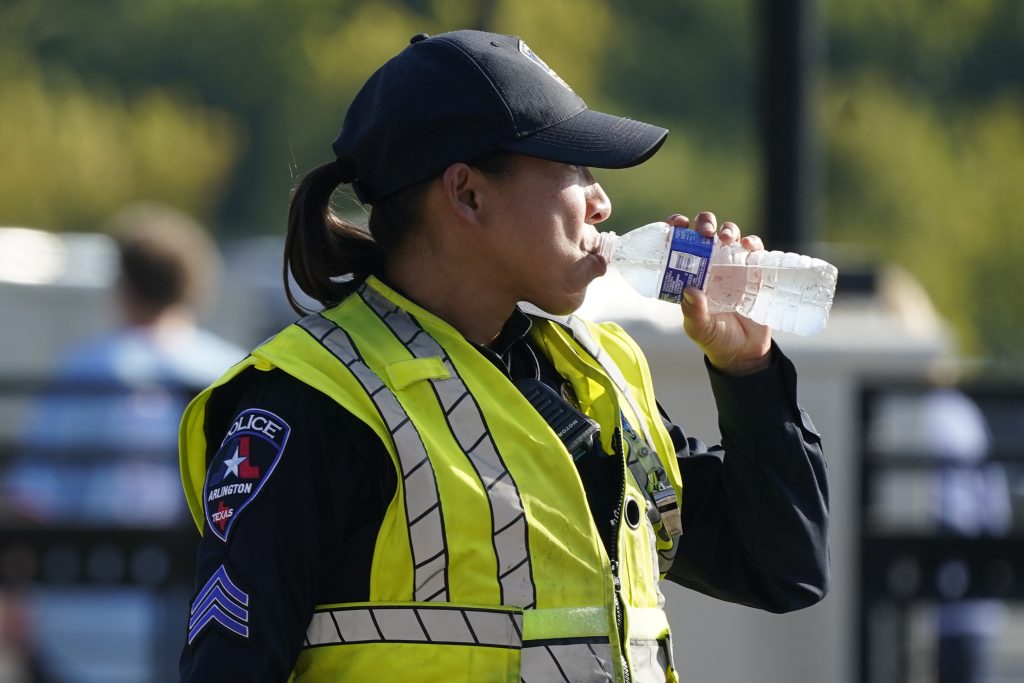Sweltering temperatures bring misery to large portion of central US, setting heat records

A police officer directing traffic takes a break to drink water after a sporting event in Arlington, Texas, Saturday, Aug. 19, 2023. The summer of 2023 may be drawing to a close — but the extreme heat is not: More record-shattering temperatures — this time across Texas — are expected Saturday and Sunday as the U.S. continues to bake. (AP Photo/LM Otero)
By JUAN A. LOZANO Associated Press
HOUSTON (AP) — Sweltering temperatures lingered Sunday in a large swath of the central U.S., causing misery from the Gulf of Mexico to the Great Lakes.
Record high temperatures were recorded in Texas and other states. People were told to chug extra water while mowing lawns or exercising outdoors, and to check on neighbors to ensure air conditioning is available. The extreme heat prompted Texas’ electric power grid manager to ask residents to voluntary conserve power for three hours on Sunday night.
“These high temperatures can impact our friends, families, and neighbors who may live alone, especially if they limit their use of air conditioning,” Sarah Russell, commissioner for the St. Louis Emergency Management Agency, said in a statement. “We urge everyone to stop and visit loved ones to ensure they are healthy and well during this extreme heat.”
The Dallas-Fort Worth area was expected to reach 110 F (43.3 C) Sunday after hitting 108 F (42.2 C) Saturday, said Sarah Barnes, a meteorologist with the National Weather Service. The record high for those dates was 107 F (41.7 C), set in 2011.
The area is not cooling off enough at night, Barnes said.
“That’s really going to contribute to an increased risk of heat-related illnesses,” Barnes said Sunday. “That’s the main concern when it comes to people and the heat.”
The Electric Reliability Council of Texas, or ERCOT, on Sunday asked the state’s 30 million residents to voluntarily reduce power use from 7 p.m. to 10 p.m. CDT because of “extreme temperatures, continued high demand and unexpected loss of thermal generation.”
ERCOT’s request for voluntary power conservation was the second such request in the past three days. The agency said it was not in emergency operations. Many residents still view the power grid nervously more than 2.5 years after a deadly winter blackout.
The heat wave causing misery this weekend is just the latest to punish the U.S. this year.
Scientists have long warned that climate change, driven by the burning of fossil fuels, by deforestation and by certain agricultural practices, will lead to more and prolonged bouts of extreme weather, including hotter temperatures.
The entire globe has simmered to record heat both in June and July. And if that’s not enough, smoke from wildfires, floods and droughts have caused problems globally.
The National Weather Service set an excessive heat warning Sunday for parts of Texas, Louisiana, Arkansas, Oklahoma, Kansas, Missouri, Illinois, Iowa and Nebraska. Heat advisories or watches were also in place in parts of Alabama, Mississippi, Tennessee, Kentucky, Indiana, Wisconsin, Minnesota and South Dakota.
Tourism in New Orleans often slows during the peak of summer heat, and that’s happening as temperatures approach 100 F (37.8 C).
NOLA Poboys is closing two days a week for now, said Lucas McQueen, one of the restaurant’s chefs. “I can’t wait to be complaining about being cold,” McQueen told WWL-TV.
The temperature reached a record high for the date of 104 F (40 C) Saturday in Jackson, Mississippi, as people walked between indoor and outdoor events at the Mississippi Book Festival. Volunteers distributed chilled water, and people used handheld fans while chatting with authors and shopping for books at large tents outside the state Capitol building.
Houston on Sunday added to its ongoing streak of high temperatures at or above 100 F (37.8 C). Through Sunday, the high temperature in Houston has been at least 100 F for 22 days. Sunday’s high was 108 F (42.2 C), breaking a record for the date that goes back to 1909.
The stifling heat in Texas overwhelmed people taking part in orientation for new students at Prairie View A&M University, 48 miles (77 kilometers) northwest of Houston. University officials said they were reviewing operations after 38 students were hospitalized Friday night after suffering heat-related illnesses, including dehydration. One student was taken by helicopter to a hospital in nearby College Station, while 37 were taken in ambulances to other facilities, Waller County EMS Chief Rhonda Getschman told KBTX.
“It’s very easy to overheat quickly in this Texas heat. We highly encourage everyone to stay indoors as much as possible,” Getschman said.
Much of Iowa is expected to see high temperatures in the upper 90s Sunday and Monday, followed by three days where the reading will likely top 100 F (37.8 C).
The heat was worrisome for Sunday as thousands were expected for the final day of the Iowa State Fair in Des Moines. In a Facebook post, fair officials urged patrons to visit air-conditioned buildings, take regular breaks and stay hydrated.
Forecasters expected high temperatures to reach 99 F (37.2 C) to 103 F (39.4 C) through Friday in St. Louis, and the heat’s only part of the problem: Excessive humidity will lead to a heat index of up to 115 F (46.1 C) each day. The St. Louis Post-Dispatch reported that if the prediction holds, it will be the worst stretch of heat in St. Louis since August 2014, when temperatures rose to about 95 F (35 C) for seven straight days.
Similar heat is expected all week in Little Rock, Arkansas, prompting the community to open several cooling centers for people who live on the streets or without air conditioning.
Last month, the Phoenix area broiled under a record-setting 31 days of daily high temperatures of 110 F (43.4 C) or above. The historic heat began blasting the region in June, stretching from Texas across New Mexico and Arizona and into California’s desert. The previous record was 18 straight days in 1974. In July, the continental United States set a record for overnight warmth, providing little relief from daytime heat for people, animals, plants and the electric grid, meteorologists said.
The Centers for Disease Control and Prevention reports just 600 to 700 heat deaths annually in the United States. But experts say the mishmash of ways that more than 3,000 counties calculate heat deaths means the public doesn’t really know how many people die in the U.S. each year.
Associated Press writers Jim Salter in St. Louis, Jackie Quinn in Washington and Emily Wagster Pettus in Jackson, Mississippi, contributed to this report.









